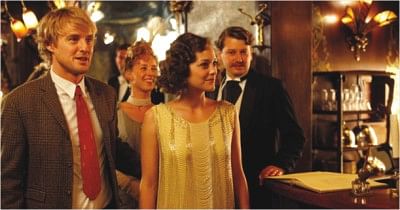Decoding Woody Allen's Midnight in Paris

Owen Wilson (left) is Gil, who travels back in time to 1920s' Paris, and Marion Cotillard is Adriana, a fictional mistress of Picasso who catches Gil's eye.
Many a writer or artist has longed to travel back in time to the sizzling Paris of the 1920s, to sip absinthe with Hemingway at Les Deux Magots or dine on choucroute garnie with Picasso at La Rotonde. Imagine the conversation! What has beguiled audiences about the new Woody Allen movie, “Midnight in Paris,” is that the protagonist, Gil, a disenchanted Hollywood screenwriter played by Owen Wilson, gets to live exactly that fantasy.
He runs into Scott and Zelda Fitzgerald at an elegant soiree, where he hears Cole Porter crooning “Let's Do It (Let's Fall in Love).” He gets writing advice from a laconic Hemingway, persuades Gertrude Stein to read the manuscript of his novel, and falls in love with Picasso's mistress. He meets Salvador Dalí, T. S. Eliot, Djuna Barnes, Josephine Baker, Luis Buñuel, Man Ray and others in the enormously talented cast of expatriates and bohemians that peopled Jazz Age Paris. Reeling from the folly of World War I and so offering fodder for novels and paintings dripping with disillusionment, Paris was the centre of the artistic universe then, and those legends really did converge on Paris around the same time.
“If you are lucky enough to have lived in Paris as a young man then wherever you go for the rest of your life, it stays with you, for Paris is a moveable feast,” Hemingway wrote in “A Moveable Feast,” his memoir that was posthumously published in 1964.
The movie sometimes assumes viewers know the details of these luminous lives, so it may be helpful to understand some of the complicated relationships that made Paris in that era both a dream and often something less.
In 1922 Hemingway and his first wife, Hadley, took a two-room flat near the Sorbonne that had no hot water and no indoor toilet. He also rented a room around the corner to write, something like the “attic with a skylight” Gil craves. It had a view of the smokestacks and rooftops that Mr. Allen captures in worshipful shots of the city.
Gil meets Hemingway in a run-down cafe not unlike the legendary Dingo, where Hemingway's less than beautiful friendship with Fitzgerald began with the latter's drunken near-blackout. Hemingway, who is parodied in the film with dialogue like “no subject is terrible if the story is true and if the prose is clean and honest,” was envious of the seemingly effortless lyricism of Fitzgerald's writing in works like “The Great Gatsby.” In “Midnight in Paris,” Hemingway tells Fitzgerald that Zelda, a writer herself, sees her husband as a competitor. But “A Moveable Feast” offers a more full-throated account. Hemingway grew to despise Zelda, partly because she had betrayed Fitzgerald with a French aviator and partly because he blamed her decadent tempestuousness for ruining her husband's productivity.
Picasso and Matisse, who appear in the film, also had a rivalry, barely acknowledged in the film, with the two artists echoing -- some critics say swiping -- each other's themes. Both gained the attention of the art collector Leo Stein and his sister, Gertrude. In the film Gil hears that Gertrude Stein has bought a Matisse for 500 francs and, in the hope of making a time-bending killing, asks her if he could pick up “six or seven” Matisses as well. The twice-married Picasso was famous for mistresses, and in the film Marion Cotillard plays Adriana, a capricious, if melancholy stand-in for all of Picasso's lovers, models and muses. She claims to have been the lover of Modigliani and Braque as well.
When Gil sits down in a cafe with Dalí and Man Ray, he confides to those artists his shock at being catapulted back in time. Man Ray is delighted with the idea, but Gil tells him that's because “you're a Surrealist and I'm a normal guy.”

 For all latest news, follow The Daily Star's Google News channel.
For all latest news, follow The Daily Star's Google News channel. 



Comments